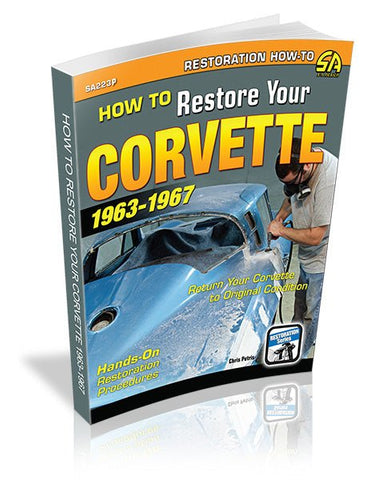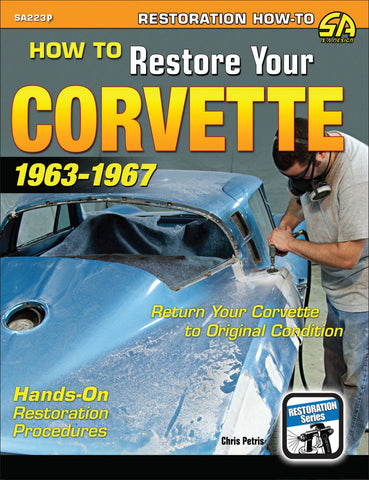The photos in this edition are black and white.
The Corvette is in a league of its own. With a fanatical following and legendary performance reputation, GM has continuously produced model after memorable model starting in 1953 and continuing today. As long as there is a car culture, the Corvette will continue to appeal to legions of enthusiasts. As such, these most of these cars will require a restoration during their lifetime, and that's where this book comes in. While some Corvette concourse restorations will be entrusted to professional restoration shops, many knowledgeable and skilled owners take pride in performing restoration work on their own.
The Corvette C2, or second generation Corvette, is among the most popular of all Corvettes ever built. This book offers an ample amount of step-by-step information in color and focus on real-world restoration techniques. In addition, it contains essential authenticity information and key considerations involved in the restoration process. This guide will cover all aspects of the restoration process, including engines and drivelines, bodywork, paint, interior and trim, suspension, brakes, chassis, and steering.
Author Chris Petris owns and runs Petris Enterprises, a respected Corvette restoration and parts supply business and has been a Bloomington Gold School Technical Instructor for 9 years. Corvette owners are a discriminating group and you are shown how to restore your car and retain the originality of the car within practical budgets. Whether you would like to try and tackle your own restoration, or simply want to know how the successful pros like Petris do it, this Restoration Series title has you covered.
About the Author
Acknowledgments
Introduction
Chapter 1: Choose Your Corvette
Fiberglass Bodies
Handling
NCRS and Bloomington Gold
Collector Values
Exterior/Interior Differences
Options
Skills and Capabilities
Chapter 2: A Corvette by the Numbers: What to Look For
Codes, Codes, Codes
Inspection Results
Analyzing a Potential Project
Chapter 3: Getting Started
Types of Restoration
Shop/Garage Requirements
Parts Cleaning
Paint Preparation
Equipment Needs
Sourcing Parts
Disassembly
Lifting the Body
Chapter 4: Bodywork
Components to Consider
Inspection
Fiberglass Repair
Fiberglass Panel Replacement
Fiberglass Panel Removal
Frame Repair
Prepping to Paint
Chapter 5: Paint
Safety Concerns
Choose a Shop
Should You Do It Yourself?
Paint Types
NCRS or Bloomington Gold Paint Refinishing
Practice Applying Paint
Paint Facilities
Body Prep
Post-Paint Work
Body Reinstallation
Chapter 6: Engines
Other Factors to Consider
Engine Disassembly
Machine Shop Service
Short Block Assembly
Top End Assembly
Valve Adjustment
Alternative Engine Options
Bloomington Gold/NCRS Requirements
Chapter 7: Transmissions
Identification
Disassembly
Inspection
Assembly
Transmission Options
Chapter 8: Driveline Restoration
Clutch Linkage
Bellhousing
Differential
Install Driveshaft/Axleshaft
Chapter 9: Brakes
1963–1965 Drum Brakes
Drum Brake Options
Hydraulic System
Master Cylinders
Brake Lines, Fittings, Hardware
Power or Manual Brakes?
Brake Fluid
Parking Brakes
Chapter 10: Suspension
Design Innovations
Alignment Terms
Suspension Restoration
Rear Wheel Bearing Service
Make a Plan of Attack
Chassis Disassembly
Subassembly Disassembly
Rear Trailing Arm Installation
Steering System Installation
Subassembly Installation
Component Installation
Chapter 11: Electrical and Wiring
Electrical System Inspection
Wiring Advances
Component Restoration
Alternators
Using a Multi-Meter
Starter Motors
Ignition Distributors
Electric Motors
Gauge Clusters
Chapter 12: Interior
Seat Covers
Headliner and Insulation
Cowl Vents
Dash Assembly
Carpet
Window Trim
Seats
Door Panels
Convertible Top
Hardtop
Chapter 13: Other Components
Fuel System
Mechanical Fuel Injection
Cooling System
Air Conditioning
Sound System
Ignition Shielding
Wheels and Tires
Power Steering
Power Windows
Exhaust System
Windshield and Glass
Source Guide
The photos in this edition are black and white.
The Corvette is in a league of its own. With a fanatical following and legendary performance reputation, GM has continuously produced model after memorable model starting in 1953 and continuing today. As long as there is a car culture, the Corvette will continue to appeal to legions of enthusiasts. As such, these most of these cars will require a restoration during their lifetime, and that's where this book comes in. While some Corvette concourse restorations will be entrusted to professional restoration shops, many knowledgeable and skilled owners take pride in performing restoration work on their own.
The Corvette C2, or second generation Corvette, is among the most popular of all Corvettes ever built. This book offers an ample amount of step-by-step information in color and focus on real-world restoration techniques. In addition, it contains essential authenticity information and key considerations involved in the restoration process. This guide will cover all aspects of the restoration process, including engines and drivelines, bodywork, paint, interior and trim, suspension, brakes, chassis, and steering.
Author Chris Petris owns and runs Petris Enterprises, a respected Corvette restoration and parts supply business and has been a Bloomington Gold School Technical Instructor for 9 years. Corvette owners are a discriminating group and you are shown how to restore your car and retain the originality of the car within practical budgets. Whether you would like to try and tackle your own restoration, or simply want to know how the successful pros like Petris do it, this Restoration Series title has you covered.
About the Author
Acknowledgments
Introduction
Chapter 1: Choose Your Corvette
Fiberglass Bodies
Handling
NCRS and Bloomington Gold
Collector Values
Exterior/Interior Differences
Options
Skills and Capabilities
Chapter 2: A Corvette by the Numbers: What to Look For
Codes, Codes, Codes
Inspection Results
Analyzing a Potential Project
Chapter 3: Getting Started
Types of Restoration
Shop/Garage Requirements
Parts Cleaning
Paint Preparation
Equipment Needs
Sourcing Parts
Disassembly
Lifting the Body
Chapter 4: Bodywork
Components to Consider
Inspection
Fiberglass Repair
Fiberglass Panel Replacement
Fiberglass Panel Removal
Frame Repair
Prepping to Paint
Chapter 5: Paint
Safety Concerns
Choose a Shop
Should You Do It Yourself?
Paint Types
NCRS or Bloomington Gold Paint Refinishing
Practice Applying Paint
Paint Facilities
Body Prep
Post-Paint Work
Body Reinstallation
Chapter 6: Engines
Other Factors to Consider
Engine Disassembly
Machine Shop Service
Short Block Assembly
Top End Assembly
Valve Adjustment
Alternative Engine Options
Bloomington Gold/NCRS Requirements
Chapter 7: Transmissions
Identification
Disassembly
Inspection
Assembly
Transmission Options
Chapter 8: Driveline Restoration
Clutch Linkage
Bellhousing
Differential
Install Driveshaft/Axleshaft
Chapter 9: Brakes
1963–1965 Drum Brakes
Drum Brake Options
Hydraulic System
Master Cylinders
Brake Lines, Fittings, Hardware
Power or Manual Brakes?
Brake Fluid
Parking Brakes
Chapter 10: Suspension
Design Innovations
Alignment Terms
Suspension Restoration
Rear Wheel Bearing Service
Make a Plan of Attack
Chassis Disassembly
Subassembly Disassembly
Rear Trailing Arm Installation
Steering System Installation
Subassembly Installation
Component Installation
Chapter 11: Electrical and Wiring
Electrical System Inspection
Wiring Advances
Component Restoration
Alternators
Using a Multi-Meter
Starter Motors
Ignition Distributors
Electric Motors
Gauge Clusters
Chapter 12: Interior
Seat Covers
Headliner and Insulation
Cowl Vents
Dash Assembly
Carpet
Window Trim
Seats
Door Panels
Convertible Top
Hardtop
Chapter 13: Other Components
Fuel System
Mechanical Fuel Injection
Cooling System
Air Conditioning
Sound System
Ignition Shielding
Wheels and Tires
Power Steering
Power Windows
Exhaust System
Windshield and Glass
Source Guide










